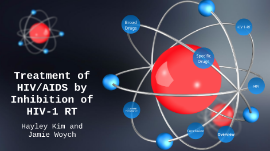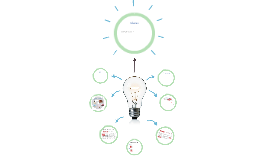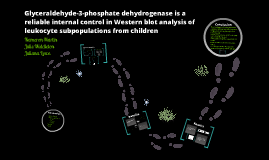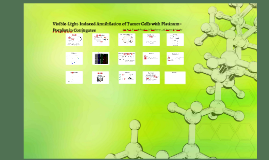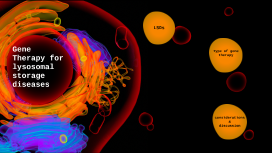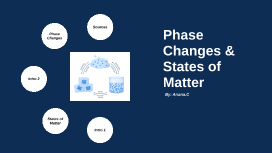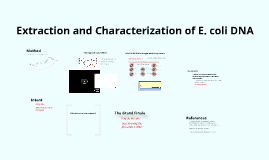Biochem Presentation
Transcript: Future Research E. D. Steinberg et al. , 1998 A2780 (ECACC 93112519) Wavelengths tested don't penetrate far into tissue: Toxicity of Tetraplatinated Poryphrins in Cell Culture Platinum Based Pharmaceuticals Domcke, Silvia et al. "Evaluating Cell Lines As Tumour Models By Comparison Of Genomic Profiles". Nature Communications 4 (2013). Harvested from untreated patient Cisplatin Sensitive Ovarian Carcinoma Cells Viscosity Testing Produce extracellular structural proteins (eg collagen, elastic fibers HeLa Cells Paul Goodland, Kim Fields, and Peter Zhang, n. d. Naik et al. 2014 Control Porphyrins Cisplatin Resistant Ovarian Carcinoma Cells Conjugated, aromatic heterocycles Naturally occurring- heme, chlorophyll, cytochromes, vitamin B12 Four nitrogen in middle can coordinate to metals Absorb light > electron promoted > upon return to ground state, energy transferred to molecular oxygen, producing singlet oxygen Photocleavage Oldest human cell line Kelland, Lloyd. "The Resurgence Of Platinum-Based Cancer Chemotherapy". Nature Reviews Cancer 7.8 (2007): 573-584. Localization Guanosine Binding ROS can damage nucleic acids, and oxidize fats, proteins, and cofactors Photosensitizer activated by light Generates ROS, induce cell death Can precisely control when, where activated Promising cancer treatment Merged Combine photodynamic therapy and platinum Kelland, 2007 These compounds localized to the nucleus Characterization DIC Anu Naik, Riccardo Rubbiani, Gilles Gasser, and Bernhard Spingler http://www.phe-culturecollections.org.uk Normal human fetal lung cell line used Naik et al. 2014 Naik et al. 2014 2 Conclusions A2780cis (ECACC 93112517) EtBr Competition Assay DNA Binding ISTOCKPHOTO/THINKSTOCK Immortal Play role in tumor inflammation response via ECM remodeling Cell Culture Nedime Serakinci, Rikke Christensen and Umut Fahrioglu, 2011 Nedime Serakinci, Rikke Christensen, and Umut Fahrioglu. Transformation Of Mesenchymal Stem Cells. 1st ed. INTECH Open Access Publisher, 2011. Convert large molecules to gaseous ionic state for mass spec For all compounds tested, high concentration needed to kill cells in dark; low concentration needed to kill cells with light exposure 3 Cervical cancer Dolmans, Fukumura and Jain, 2003 Research Approach Dolmans, Dennis E.J.G.J., Dai Fukumura, and Rakesh K. Jain. "TIMELINE: Photodynamic Therapy For Cancer". Nature Reviews Cancer 3.5 (2003): 380-387. IR HNMR PtNMR ESI-MS Elemental analysis UV/Vis spectroscopy Same as in previous slide, but resistant to cisplatin Human Fibroblasts They bind to guanosine in DNA and DNA is damaged upon exposure to 420 nm light Mitotracker The tetraplatinated compounds synthesized were toxic cancer to cells upon exposure to light http://www.phe-culturecollections.org.uk References Angelo Frei, Wikimedia Common, 2013 Potentially not suitable as ovarian cancer model (Domcke et. al, 2013), probably fine for this research Provides ability to control temporal, spatial activation of drug + action of Pt based compounds Sternberg, Ethan D, David Dolphin, and Christian Brückner. "Porphyrin-Based Photosensitizers For Use In Photodynamic Therapy". Tetrahedron 54.17 (1998): 4151-4202. Naik et al. 2014 Visible-Light-Induced Annihilation of Tumor Cells with Platinum– Porphyrin Conjugates DAPI Elucidate mechanism of DNA cleavage Determine if results similar in vivo Determine if compounds always intercalate with DNA, or only upon light exposure- potential issues if intercalates in dark Mixed cell culture, determine if differential localization based on cell type 4 Naik et al. 2014 Photodynamic Therapy HeLa cells Human fibroblasts Cisplatin sensitive ovarian carcinoma cells Cisplatin resistant cells ovarian carcinoma cells Poryphrin Synthesis Compound Binding of compound 4 results in the formation of new downfield shifted peaks UV/Vis Absorbance Changes with addition of DNA to Compound 4 Naik, Anu et al. "Visible-Light-Induced Annihilation Of Tumor Cells With Platinum-Porphyrin Conjugates". Angewandte Chemie 126.27 (2014): 7058-7061. 1 https://www.atcc.org/products/all/CCL-171.aspx#characteristics






